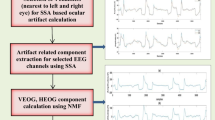Abstract
This paper presents a technique for the removal of ocular artifacts from electro-encephalogram (EEG) by using adaptive filtering. The major concern is electro-oculogram (EOG) signal present in a recorded EEG signal, which appears due to abrupt eye movements. In the presented method, we use separately recorded horizontal EOG (HEOG) and vertical EOG (VEOG) signals as two reference inputs, which are processed using finite impulse response (FIR) filters. The linear filter coefficients are adaptively updated using a numerical variable forgetting factor (NVFF) recursive least squares (RLS) algorithm, which tracks nonstationary EOG signals. Subsequently, the processed HEOG and VEOG signals are subtracted from recorded EEG signal to obtain an artifact-free EEG signal. Simulation is conducted using synthetic EEG signal corrupted by noise, synthetic HEOG and VEOG signals. The real-time recorded EEG signal (corrupted by EOG and noise) is also refined using the separately recorded reference EOG signals and FIR filtering technique. For synthetic and real-time signals, the simulation results are presented to demonstrate that linear NVFF-RLS algorithm-based artifact and noise excision technique outperforms conventional fixed forgetting factor RLS, fixed step-size NLMS and generalized variable step-size NLMS algorithms, in terms of the reduction in mean-squared error, under low as well as high signal-to-noise ratio conditions.







Similar content being viewed by others
References
Y.S. Cho, S.B. Kim, E.J. Powers, Time-varying spectral estimation using AR models with variable forgetting factor. IEEE Trans. Signal Process. 39(6), 1422–1426 (1991)
J.T. Connor, R.D. Martin, L.E. Atlas, Recurrent neural networks and robust time series prediction. IEEE Trans. Neural Netw. 5(2), 240–254 (1994)
A.G. Correa, E. Laciar, H.D. Patino, M.E. Valentinuzzi, Artifact removal from EEG signals using adaptive filters in cascade. J. Phys. Conf. Ser. 90(1), 1–10 (2007)
R.J. Croft, R.J. Barry, Removal of ocular artifact from the EEG: a review. Neurophysiol. Clin. 30(1), 5–19 (2000)
A. Erfanian, B. Mahmoudi, Real-time ocular artifact suppression using recurrent neural network for electro-encephalogram based brain–computer device. Med. Biol. Eng. Comput. 43(2), 296–305 (2005)
H. Garg, A.K. Kohli, EEG spike detection technique using output correlation method—a Kalman filtering approach. Circuits Syst. Signal Process. 34(8), 2643–2665 (2015)
S. Haykin, Adaptive Filter Theory, 4th edn. (Pearson Education, New York, 2002)
P. He, G. Wilson, C. Russell, Removal of ocular artifacts from electro-encephalogram by adaptive filtering. Med. Biol. Eng. Comput. 42(3), 407–412 (2004)
T.P. Jung, S. Makeig, M. Westerfield, J. Townsend, E. Courchesne, T.J. Sejnowski, Removal of eye activity artifacts from visual event-related potentials in normal and clinical subjects. Clin. Neurophysiol. 111(10), 1745–1758 (2000)
T.P. Jung, S. Makeig, C. Humphries, T.W. Lee, M.J. Mckeown, V. Iragui, T.J. Sejnowski, Removing electroencephalographic artifacts by blind source separation. Psychophysiology 37(2), 163–178 (2000)
J.L. Kenemans, P.C. Molenaar, M.N. Verbaten, J.L. Slangen, Removal of ocular artifact from the EEG: a comparison of time and frequency domain methods with simulated and real data. Psychophysiology 28(1), 114–121 (1991)
A.K. Kohli, D.K. Mehra, Tracking of time-varying channels using two-step LMS-type adaptive algorithm. IEEE Trans. Signal Process. 54(7), 2606–2615 (2006)
A.K. Kohli, A. Rai, M.K. Patel, Variable forgetting factor LS algorithm for polynomial channel model. ISRN Signal Process. 2011, 1–4 (2011)
A.K. Kohli, A. Rai, Numeric variable forgetting factor RLS algorithm for second-order Volterra filtering. Circuits Syst. Signal Process. 32(1), 223–232 (2013)
S. Mehrkanoon, M. Moghavvemi, H. Fariborzi, Real time ocular and facial muscle artifacts removal from EEG signals using LMS adaptive algorithm, in Proceedings of International Conference on Intelligent and Advanced Systems (Kuala Lumpur, 2007), pp. 1245–1250
B. Noureddin, P.D. Lawrence, G.E. Birch, Effect of task and EEG-based reference signal on performance of on-line ocular artifact removal from real EEG, in Proceedings of IEEE/EMBS Conference on Neural Engineering (Turkey, 2009), pp. 614–617
A. Rai, A.K. Kohli, Adaptive polynomial filtering using generalized variable step-size least mean pth power (LMP) algorithm. Circuits Syst. Signal Process. 33(12), 3931–3947 (2014)
A. Rai, A.K. Kohli, Volterra filtering scheme using generalized variable step-size NLMS algorithm for nonlinear acoustic echo cancellation. Acta Acust. United Acust. 101(4), 821–828 (2015)
R. Verleger, T. Gasser, J. Mocks, Correction of EOG artifacts in event-related potentials of the EEG: aspects of reliability and validity. Psychophysiology 19(4), 472–480 (1982)
K. Wagner, M. Doroslovacki, Proportionate-Type Normalized Least Mean Square Algorithms (Wiley, New Jersey, 2013)
J.L. Whitton, F. Lue, H. Moldofsky, A spectral method for removing eye movement artifacts from the EEG. Electroencephalogr. Clin. Neurophysiol. 44(6), 735–741 (1978)
J.C. Woestenburg, M.N. Verbaten, J.L. Slangen, The removal of eye-movement artifact from the EEG by regression analysis in the frequency domain. Biol. Psychol. 16(1–2), 127–147 (1983)
X. Yu, Z. He, Y. Sheng, Time-varying adaptive filters for evoked potential estimation. IEEE Trans. Biomed. Eng. 41(11), 1062–1071 (1994)
X.H. Yu, Y.S. Zhang, Z.Y. He, Peak component latency-correlated average method for evoked potential waveform estimation. IEEE Trans. Biomed. Eng. 41(11), 1072–1082 (1994)
Acknowledgments
Authors are thankful to Dr. Poonam Gakhar Kohli, Associate Professor, Physiology Department, Punjab Institute of Medical Science Jalandhar, affiliated to Baba Farid University, Punjab, India, for her fruitful suggestions and motivational discussions regarding Physiology and Neurology. However, the EEG signals (publicly available) can be downloaded from a web page entitled with EEG recordings database on https://www.physionet.org.
Author information
Authors and Affiliations
Corresponding author
Ethics declarations
Conflict of interest
Harish Kumar Garg and Amit Kumar Kohli declare that they have no conflict of interest in relation to the research work presented in this article.
Rights and permissions
About this article
Cite this article
Garg, H.K., Kohli, A.K. Excision of Ocular Artifacts from EEG Using NVFF-RLS Adaptive Algorithm. Circuits Syst Signal Process 36, 404–419 (2017). https://doi.org/10.1007/s00034-016-0293-8
Received:
Revised:
Accepted:
Published:
Issue Date:
DOI: https://doi.org/10.1007/s00034-016-0293-8




